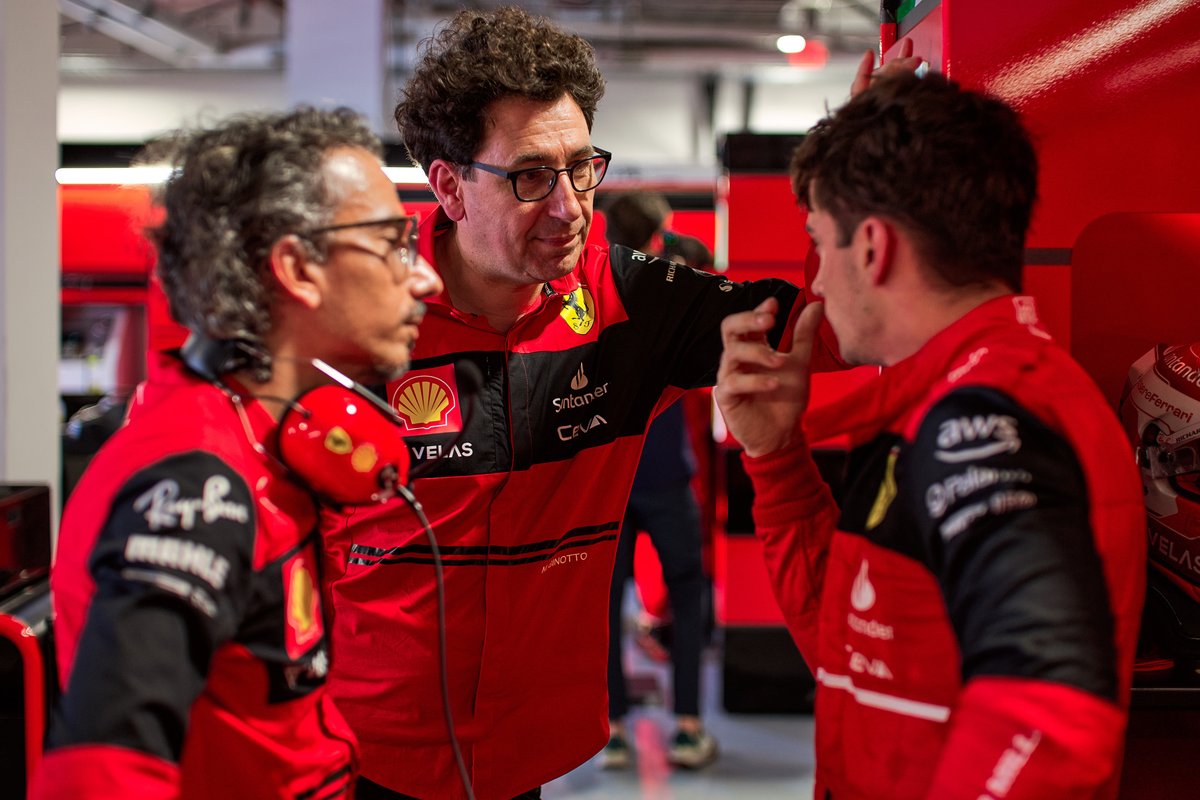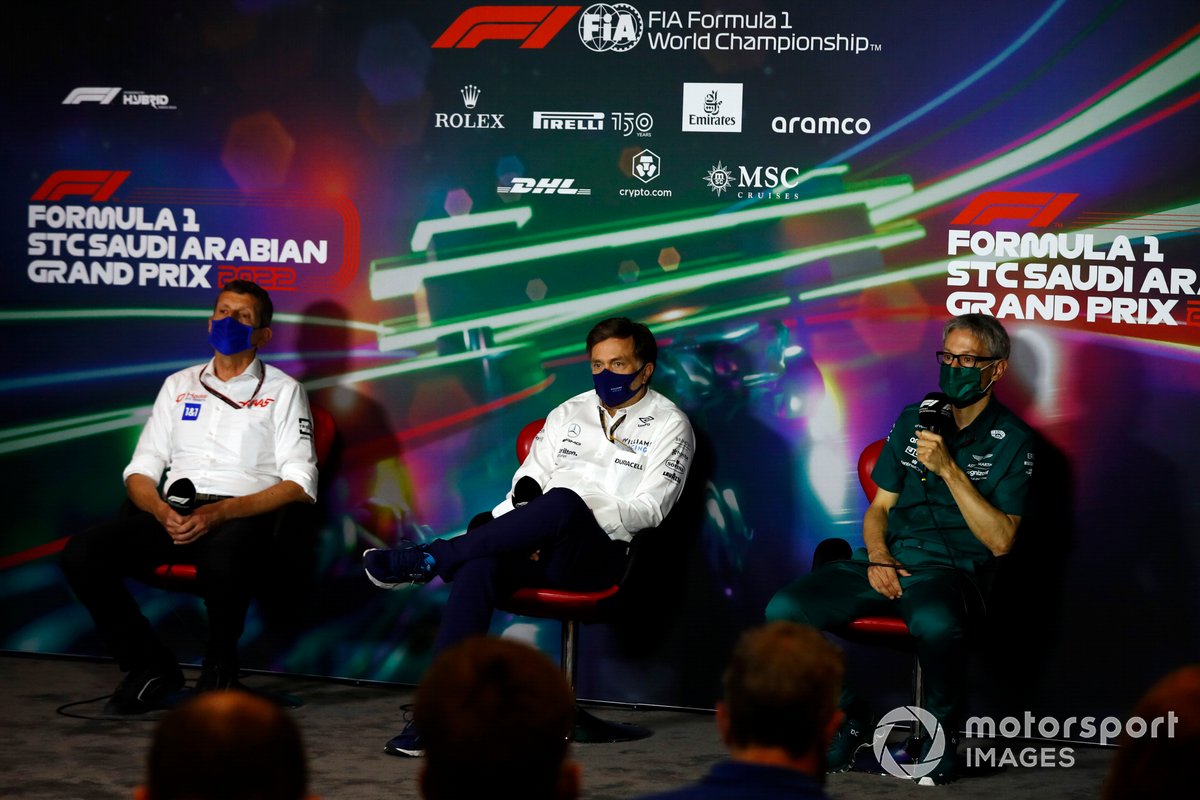
It was perhaps inevitable therefore that with the implementation of the FIA financial regulations the focus would move towards how closely those new rules are being followed.
The top teams are all well aware how tight their own budgets are this year, and they know how carefully they have to control funds spent on development. They now have to pace themselves over the season to make the best possible use of their limited resources to introduce upgrades that work, in effect getting the biggest bang for their buck.
Ferrari’s strategy has been to make the most of its initial car package, while holding back on introducing significant updates until this weekend’s race in Barcelona. Meanwhile the team has watched the progress made by rivals Red Bull with some interest. In the immediate aftermath of the Miami Grand Prix team principal Mattia Binotto hinted that Ferrari has some questions about how that progress is being made within the current constraints.
“It's true that Red Bull improved their car,” he said. “Since the very start of the season they introduced upgrades, and today if I look at the last two races, maybe they got a couple of tenths per lap faster to us.
“I hope, because there is as well a budget cap, that at some stage Red Bull will stop development, otherwise I will not understand how they can do that.”
In the context of further questioning about the relative form of the two teams, he added: “If there is a concern it’s how much they are developing considering the budget cap. That's certainly a concern we have got. But more than a concern, as I said maybe it is a hope, because at some stage they will need to stop…”
He wasn’t finished there. In response to a question about Ferrari’s own plans, he said: “We do not have the money to spend for upgrades at each single race. I think it is as simple as that. Not because of an inability, but because of the budget cap.
“So we need somehow to try to focus development on when we believe it's the right moment, and the right spending.”

The message was clear – Ferrari doesn’t understand how Red Bull has been able to improve its car in recent weeks without digging so deeply into its R&D budget that it won’t be able to keep up the pace as the season progresses. And the suggestion therefore was that the FIA should keep a close eye on what Red Bull is doing.
It was another signal that the financial regs will become a battleground between Ferrari and Red Bull as the title race hots up over the course of the 2022 season. Just as in the past they always considered the legality of any new parts or upgrades introduced by a rival, now teams will assess how much it will have cost.
“I think pretty much every team is pretty close to the limit this year,” Red Bull boss Christian Horner noted even before the first race.
“It’s very aggressive, so you have to be very strategic in how you apply your funds to developments, and I think rather than just running as fast as you can and getting as much performance from the car you’ve got to be much more selective in what you choose, based on its cost.”
It’s now up to the FIA, under head of financial regulations Federico Lodi, to ensure that everyone plays by the rules and that any grey areas are addressed.
A huge effort went into creating those regulations. Lodi was for three years the financial director of Toro Rosso, so he knows F1 from the inside. In creating the rules he had support from F1’s then financial boss Nigel Kerr, previously with Honda/Brawn/Mercedes, while the teams also had input on how it would all work.
It wasn’t just about the number crunchers. The technical bosses of the FIA and F1, Nikolas Tombazis and Pat Symonds, also had a lot of input on how to calculate what teams spend on developing and running the cars.
"It's clear that for the development of the regulation, we have worked very, very closely with F1,” Lodi told Motorsport.com before the rules came into force.
“I’ve known Nigel 10 years, when I was in Toro Rosso, and he was in Mercedes, and we get along well. We have developed the financial regulation jointly.
“And it's clear that there are several connections and overlaps with the technical regs. So obviously Nik and Pat are also part of the discussions, especially when we have to deal with technical matters, so treatment of components, power units, and so on.
“While on the other hand, when we talk about exclusion of costs, like marketing, HR, legal, it’s just me and Nigel.
“On top of that, we have been assisted for the whole process by Deloitte UK. They have been with us since the beginning. And they have fair experience in sporting regulation. They were the one that designed the financial fair play for UEFA.”

The regulations were refined over several years. After the teams agreed in the middle of the 2020 COVID-19 lockdown to further trim the headline numbers there was a push for even more detail.
Thus the rules now take into account subjects such as maternity leave, sick pay and how to allocate the wages of mechanics who work mainly on heritage and demo cars, but might be called into help with the current programme. Every dollar now counts as teams try to keep under the cap.
The consequences of breaching the cap will be severe, which is why there’s an ongoing debate about an upward adjustment for inflation that will create a bit of breathing space for the teams who are really close to the limit.
And yet despite all the effort that has gone into creating and honing the financial regulations there are still some doubts about how they are interpreted, and how strictly they can be enforced.
“I fully trust FIA,” Binotto said at Imola when Motorsport.com asked him if there were grey areas. “But no doubt that it’s a brand new regulation, and as all the regulations, there is always a competitive advantage if you can try to read them in the proper ways.
“It doesn't mean that there are grey areas, but it's the way that teams may understand or read or interpret the regulations themselves. So I think there is the need of a big effort from FIA to try to police. I think that in order to do that they need to reinforce the internal staff, and the number of people that somehow are auditing and policing, because it's a key element.
“I think it is as important as the technical and as the sporting regulations because as a matter of fact it is a proper regulation, or maybe today the CFOs are as important as technical directors.”
It was intriguing that Binotto highlighted that the FIA needed more staff – given that the governing body is facing a financial squeeze of its own, a big recruitment drive for extra auditors seems unlikely.
However, the FIA does now have Kerr officially on board helping Lodi - in February he left the employment of F1 to become a consultant to the governing body.
Binotto also hinted at one of the major challenges that the FIA faces in balancing things out. Every team has a slightly different business model, as some build their own engines and gearboxes and suspension parts, while others buy in some or all of those elements, to differing degrees.

Perhaps the most complicated arrangement is that in Milton Keynes, where Red Bull Racing and Red Bull Technology operate in parallel, with the latter also supplying AlphaTauri.
Binotto noted: “I think at the end, it's important that FIA put really the maximum effort into trying to understand the different assets of the different companies and teams, how they spend the money, how they justify the way they're spending it.
“And I think in that respect, it's a huge and difficult task. But we are trusting them. I'm pretty sure that they will organise themselves to do it. But I think that further effort is required.”
As the rules were formulated the FIA had to dig deep into each team’s business model, taking into account for example that Haas buys more parts from Ferrari than any other team sources externally, or that Red Bull Racing and Red Bull Technology work together.
"I think that we have addressed this in the financial regulation because in principle, Red Bull Technology will fall in the declaration of Red Bull Racing,” Lodi explained.
“So the F1 costs we say are incurred by a team, but the reality is incurred by a reporting group that is the F1 team’s legal group entities that incur F1 activity cost on behalf of the team. So Red Bull Technology will fall in the declaration of Red Bull Racing."
The consensus among other team bosses is that the system is essentially robust and works well – but there’s always scope for further tightening up and clarification as those inevitable grey areas emerge.
“The amount of work each team does with the FIA on the cost cap, on the policing of that, is immense,” says Jost Capito of Williams. “And I think there are a lot of discussions with the finance guys of the teams with the FIA, how to still improve that.
“If a team identifies a grey area, I think discussion comes up in that group. And it's just now we filed after the first year and, of course, it's such a complex system, it has to be further developed.
“And I think there is a good cooperation within all the finance directors of the teams to develop it further. But it's a lot of work with the FIA too, they police it pretty well.”
“It is like with sporting and technical regs,” says Aston Martin’s Mike Krack. “You read them carefully, and you'll see areas where you can explore more, if you call them grey or not.
“So if you go over the limit or not, you will be told like you do with technical and sporting as well.”
“I think there are always grey areas,” says Haas boss Gunther Steiner. “But I think the FIA is putting a lot of effort and good work into it to be on top as much as possible.
“Nobody's trying to pull the wool over anybody's eyes. It's like one of those things; if you find grey area to exploit it, but I think there are not a lot of loopholes to do anything which wouldn’t end up in being big penalties.”

The prospect of the 2022 F1 world championship ending up in a legal fight over how much a team spent on making its car faster is not an appealing one. After all the championship has always been about pushing the limits of technology.
However, we also have to remember the big picture. F1 is in a healthy state right now because the financial regs were introduced both to close up the field and to keep 10 healthy teams on the grid.
Stakeholders like Renault and Gene Haas could see that it was no longer a bottomless pit of spending, and thus were encouraged to remain involved. No one said that making the new rules work would be easy.
“It has been a challenge, it has been difficult,” said Lodi. “Because obviously it's a change of mindset also, because F1 has always been used to just technical and sporting regulations.
“There have been instances before where financial regulations have been tried to be implemented, but it was impossible.
“But this time, I think that everybody was very, very determined and committed in order to introduce the financial regulations, because we wanted to have a sustainable business model for the teams for the future.”







